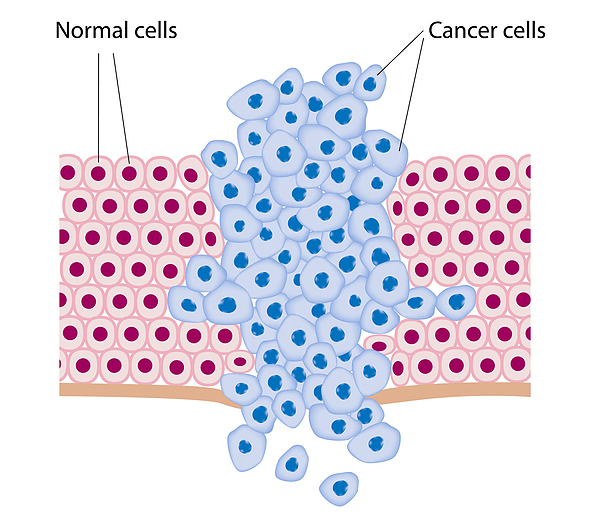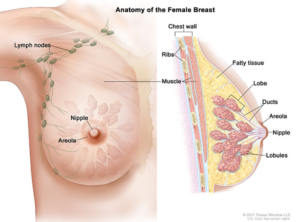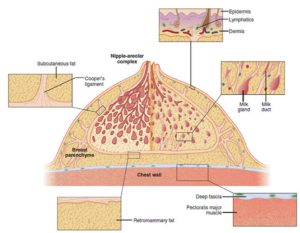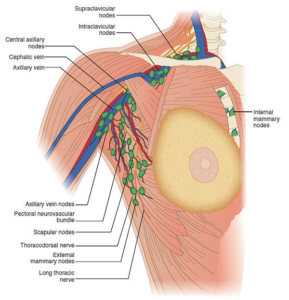Breast Cancer
In this section, we will discuss the basics of breast cancer, including a description of what it is, how it is formed, and how it may spread.
What is Cancer?
The human body consists of living cells. Normal body cells grow, divide, and die in a systematic way. Cells become cancer cells when the deoxyribonucleic acid (DNA) inside of them is damaged. DNA is found inside of every cell and controls the cell’s functions. Normal cells can repair their damaged DNA, or they die. Cancer cells do not repair their damaged DNA nor die; they continue to replicate and create more cancer cells. Damaged DNA can be inherited or caused by a mutation or mistake that occurs when a normal cell is replicating.
Cells are the building blocks of tissues. When cell growth becomes abnormal, new cells form when the body doesn’t need them, and damaged cells do not die when they are supposed to. This replication of abnormal cells often results in a mass of tissue called a lump, or tumor.
Not all tumors cause cancer. Tumors that are not cancerous are called benign and are rarely life-threatening. Tumors that are cancerous are called malignant. Malignant tumors can grow into different parts of the body. When cancer has invaded surrounding tissues, it has metastasized.

For more information watch the below video:
Breast Anatomy?
The female breasts are made up of lobules, ducts, and stroma.
Lobules are glands which produce milk.
Ducts are tubes which carry milk from the lobules to the nipple.
Stroma are connective and fatty tissue which make up the breast and encompass the ducts, lobules, blood vessels, and lymphatic vessels.

Cut-away diagram of a mature resting breast. The breast lies cushioned in fat between the overlying skin and pectoralis major muscle. The skin and the retromammary space under the breast are rich with lymphatic channels. Cooper’s ligaments, the suspensory ligaments of the breast, fuse with the overlying superficial fascia just under the dermis, coalesce as the interlobular fascia in the breast parenchyma, and then join with the deep fascia of breast over the pectoralis muscle. The system of ducts in the breast is configured like an inverted tree, with the largest ducts just under the nipple and successively smaller ducts in the periphery. After several branching generations, small ducts at the periphery enter the breast lobule, which is the milk-forming glandular unit of the breast.
The lymph system is the way which breast cancer is spread to the rest of your body. It consists of the following parts:
- Lymph nodes- small clusters of immune system cells which help fight infection
- Lymphatic vessels- tubes which carry clear fluid called lymph away from the breast
- Lymph- fluid which contains tissue, waste products, and immune cells
In the breast, most lymphatic vessels are connected to lymph nodes under the arm, called axillary nodes. Other lymphatic vessels connect to lymph nodes in the chest, called internal mammary nodes. There are also lymphatic vessels which connect above or below the collarbone, supraclavicular or infraclavicular nodes.

Contents of the axilla. In this diagram, there are five named and contiguous groupings of lymph nodes in the full axilla. Complete axillary dissection, as done in the historical radical mastectomy, removes all these nodes. However, the subclavicular nodes in the axilla are continuous with the supraclavicular nodes in the neck and nodes between the pectoralis major and minor muscles, called the interpectoral nodes in this diagram (also known as Rotter’s lymph nodes). The sentinel lymph node is functionally the first node in the axillary chain and anatomically is usually found in the external mammary group. The relative positions of the long thoracic, thoracodorsal, and medial pectoral nerves are shown. These major nerves along with the pectoral neurovascular bundle should be preserved during surgery.

For more information watch the below video:
What is Breast Cancer?
A Global Issue
According to the World Health Organization, breast cancer is the most common cancer among women worldwide, claiming the lives of hundreds of thousands of women each year and affecting countries at all levels of modernization.
Good News About Breast Cancer Trends
In recent years, perhaps coinciding with the decline in prescriptive hormone replacement therapy after menopause, we have seen a gradual reduction in female breast cancer incidence rates among women aged 50 and older. Death rates from breast cancer have been declining since about 1990, in part due to better screening and early detection, increased awareness, and continually improving treatment options.
References
